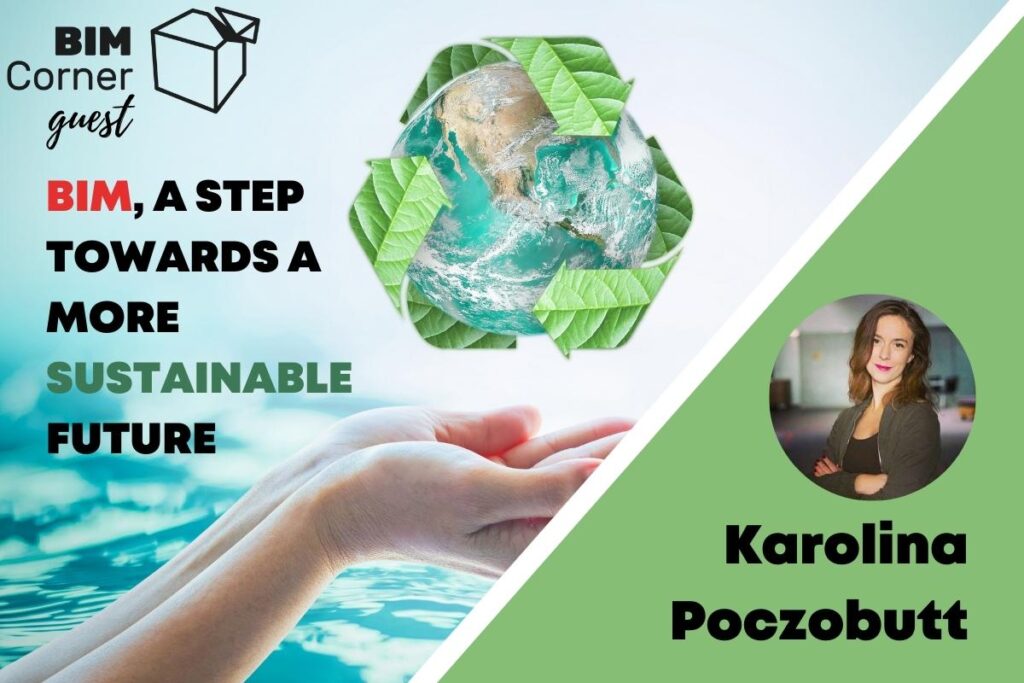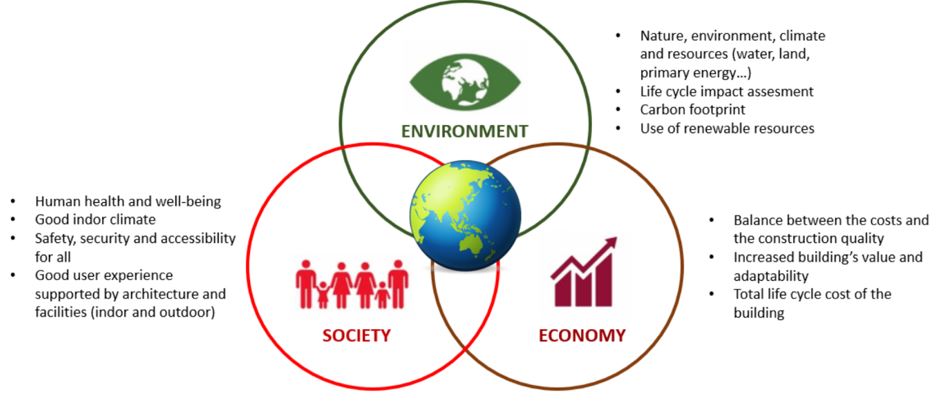In recent years sustainability has become not only a trend but a necessity, especially with the AEC industry being one of the biggest contributors to climate change. BIM creates a real possibility for architects, engineers, and manufacturers to shape a better world. In this article, you will find out what needs to be addressed when working with sustainable construction, how BIM can contribute to a healthier future, and what obstacles still need to be faced before discovering BIM’s full green potential. What you will read here applies mostly to buildings, however, some of these points will also be true for infrastructure. Without any further ado, it is time to begin.
This post was written by BIM Corner’s Guest Author, Karolina Poczobutt.
Table of contents
1. What is the proper definition of sustainability?
Until quite recently the understanding of sustainability was based mainly on its environmental aspect. However, digging a little bit further, one will realize that the environment is only one ingredient in the recipe for sustainable development. To find the rest of those ingredients, let’s have a look into the Brundtland report from 1987 – “Our common future”. Here the sustainable development is defined as the following:
“The development that meets the needs of the present without compromising the ability of future generations to meet their own needs.”
I must say, when I heard this definition for the very first time during my studies at Aalborg University, it did not tell me much. To make it even worse my head got automatically filled with a bunch of follow up questions: “Ok, but how do you meet those needs?”, “How far in the future are we talking about?” and “How does that even apply to buildings?”. A few slides further I found out that this report was the first to launch a comprehensive approach to sustainability. Sustainability, which should be seen as an interaction between different processes, their mutual dependencies, and which should include environmental, social, and economic aspects addressed in a holistic manner. To put it simply, sustainability is divided into three main areas, which are codependent, and should be taken into consideration altogether while executing a construction project. To better illustrate this train of thoughts, I added a simple diagram with examples of what can be included in every area of sustainability.
It is important to mention that sustainability should be considered throughout the entire life cycle of a project. For a better overview, please see the diagram below, which shows the ‘operational and embodied impacts of a building through its lifecycle’ (taken from this site).
2. Sustainability goals
Having the complete definition of sustainability and realizing how complex the subject actually is, one would wonder “Why should the building parties even bother with implementing sustainable principles? Aren’t construction projects already complicated enough?”. The simple answer is “Yes, they are but…” According to the statistics 25% of the Europe’s greenhouse gas emissions come from buildings and nearly 35% of the European waste is generated by the construction industry. To put it bluntly, the construction industry is a significant contributor to the ongoing climate change. Over the years the world leaders have taken multiple actions to fight the climate crisis. So, what were those actions and what were (are) their outcomes? Let’s have a quick history lesson.
1992- Rio Declaration on Environmental Development
The declaration was adopted by over 178 countries and introduced a plan of global partnership, which consisted of 27 principles. Those principles stated that human beings are entitled to live healthy and productive lives in harmony with nature. Even though many of these goals have not been met, it was a significant first step towards raising environmental awareness.
2015- The Paris Agreement
It was a legally binding international treaty on climate change that came into action in 2016. The 3 main goals of the agreement were to limit global warming to way below 2 degrees Celsius (preferably 1,5 degrees) by reducing greenhouse gas emissions, to review the progress on those every 5 years (every country was supposed to set its own climate goals) and to provide financial support to developing countries that would allow them to mitigate climate change and enable them to adapt to global changes. Ideally, the world would become climate neutral by the middle of the century. (Please, note that the goals have been reviewed this year during COP26 and resulted in a more ambitious “Glasgow Climate Pact” calling all countries to revise and strengthen their climate pledges by the end of 2022).
2015- 17 Sustainable Development Goals (SDGs)
During the same year, The United Nations has also adopted 17 Sustainable Development Goals, which are the universal actions to ensure that by 2030 all the people can enjoy their lives in peace and prosperity. That can only happen if strategies to fight poverty and other deprivations are simultaneous with improving health, education, increasing economic growth, enhancing equality, and maintaining good climate conditions.
3. How does BIM enhance sustainable development?
It is obvious that the implementation of sustainability in construction projects calls for more detailed analysis. That is exactly where BIM comes into play. As it turns out, proper information handling and well-managed digitalization of the building processes can advance each area of sustainability. The list of potential advantages is long, and it only gets longer, the more projects are executed using BIM. Therefore, I will only mention the aspects which (in my mind) are crucial.
- BIM allows for advanced analysis, which enables us to recognize a building’s behavior before it is even built. With various simulation tools, the designer can create energy-efficient buildings with a healthy indoor climate, increase the future users’ productivity and minimize costs of the possible changes in the later project stages. That applies not only to new constructions, but also to renovations.
- BIM makes it possible for the designers and clients to study multiple solutions and advantages associated with them. It allows for clash detection at the early project stage, minimizing the cost of damage control and providing safer conditions for the builders. Many companies that implement BIM record greater employee and client satisfaction, as it gives all parties the feeling of involvement.
- Thanks to the quick access to information and better data storage, the owner and facility managers get everything that is needed for the operation and maintenance of the building. Major repairs and replacement programs can be planned and synchronized, minimizing the disruption, which also increases building’s value. Moreover, EPDs (Environmental Product Declarations) are becoming available in open formats as a data set (part of the product data template), which better communicates the environmental performance of the construction products.
- BIM allows for coordination between cost planning, design, construction, and production. It also enables the manufacturers to create more accurate elements off-site. Consequently, the amount of waste is minimized, over-ordering is avoided, and the natural resources are being preserved.
4. Does BIM create a real possibility for the Integrated Design Process?
The ultimate goal of BIM is for the companies to work on the interoperable models (BIM level 3) and facilitate an integrated design process (IDP). The IDP is a promising alternative to the traditional DBB (Design-Bid-Build) or DB (Design-Build) processes. Here, the aim is to implement the expertise of all the involved specialists from day one and to build quicker, healthier, and with a lower cost, at the same time providing long-term benefits for the users and minimizing construction’s environmental impact. Unfortunately, the construction industry develops relatively slowly, which results in multiple obstacles that need to be faced, before BIM can truly contribute to sustainable development. Again, the list is long, so let me just mention the most significant ones:
- Increased project complexity and increased time spent on developing proper digital model, which makes many “old-timers” question the necessity of BIM implementation.
- Necessity to invest in new tools, software and associated with that resistance to change.
- Need for additional training (education) or new digitally experienced employees, which is always associated with additional costs.
- Need for full cooperation between building actors, transparency, and understanding of the common goal, which is delivering high quality projects and understanding each other’s disciplines.
5. Summary
To sum up, in this article the focus was set on some basic principles related to BIM and sustainability. It was proven that implementing BIM in the design processes can be a huge step towards creating a more sustainable future. Even though the issues with BIM adaptation are ongoing, I believe that its benefits will be recognized and will outweigh the drawbacks. A perfect proof of that are the Scandinavian countries, where digitalization is advancing rapidly.
I strongly encourage all the readers to have a look into some of the DGNB certified projects (DGNB is the abbreviation, in German, for the German Sustainable Building Council, about which I will write in a separate article), as many of them obtained their certifications thanks to building information modelling. In the upcoming articles related to sustainable development, we will touch on the subjects of BIM and green certifications, benefits of sustainable design and BIM in circular economy.
We have also a question to YOU! What are your experiences with BIM in sustainable construction?











